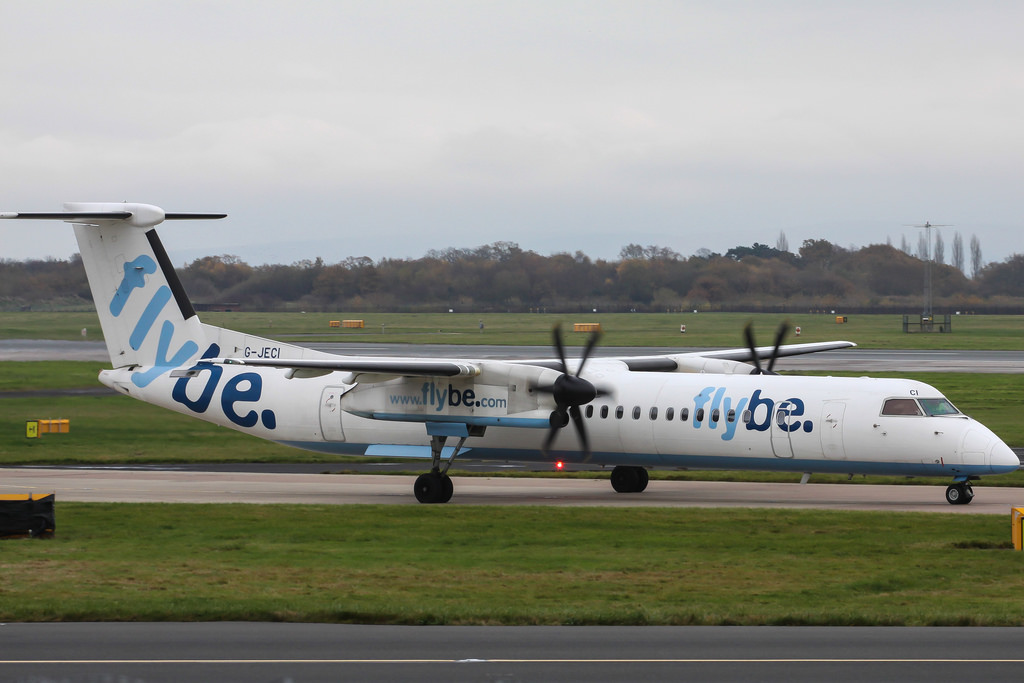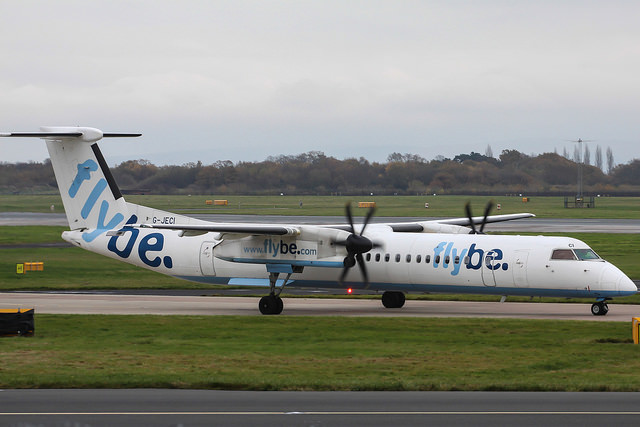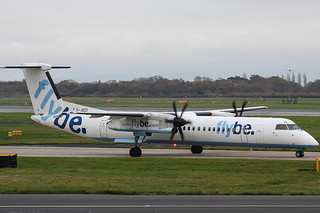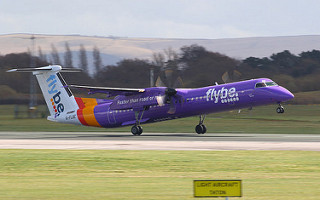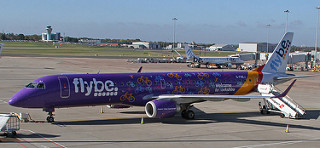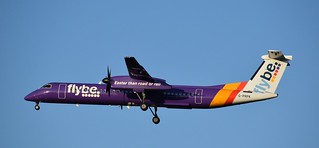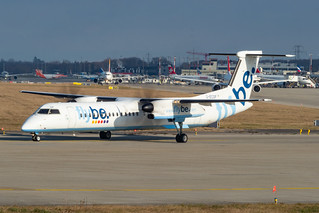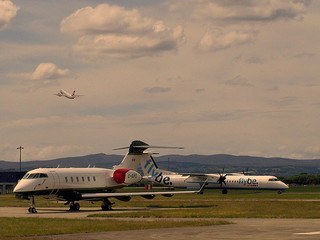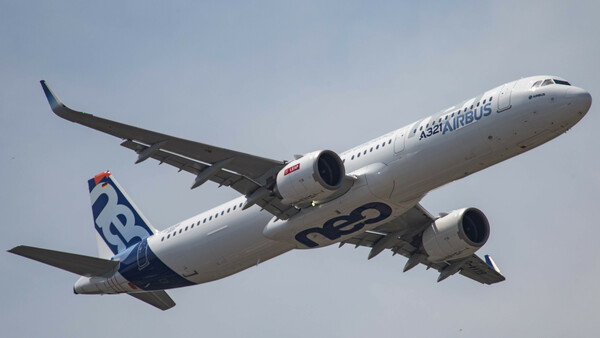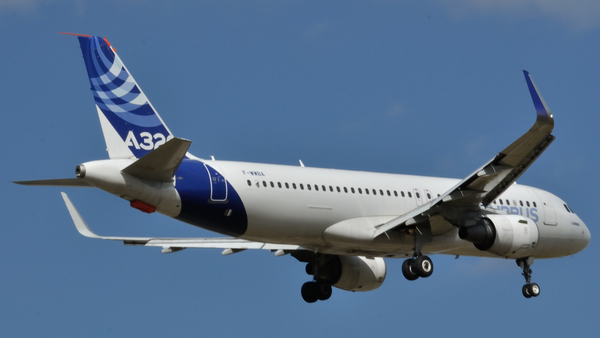Flybe DH8D near Manchester on Aug 5th 2017, first officer incapacitated
Last Update: June 14, 2018 / 20:07:08 GMT/Zulu time
Incident Facts
Date of incident
Aug 5, 2017
Classification
Incident
Airline
Flybe
Flight number
BE-1574
Departure
Inverness, United Kingdom
Destination
Jersey, United Kingdom
Aircraft Registration
G-JECI
Aircraft Type
De Havilland Dash 8 (400)
ICAO Type Designator
DH8D
The airline confirmed a medical situation in the cockpit, the captain took necessary actions quickly and efficiently and diverted the aircraft to Manchester where medical services awaited the aircraft. The passengers were rebooked onto other flights.
On Jun 14th 2018 the British AAIB released their final bulletin concluding the probable cause of the occurrence was:
This serious incident was the result of the co-pilot suffering a medical incapacitation which was professionally managed by the aircraft commander supported by the SCCM on the flight deck and the CA3 in the passenger cabin.
The AAIB reported the sequence of events:
The aircraft was en route from Inverness Airport (INV) to Jersey Airport (JER) and was established in the cruise at Flight Level (FL) 250. The workload was light and while the aircraft commander, who was the PM, was routinely looking around the flight deck, he noticed that the co-pilot was shaking, his hands and arms were tensed and that he was leaning back in his seat with his head and eyes looking up towards the ceiling. The PM called the co-pilot’s name three times but there was no response. On realising that the co-pilot was incapacitated, the PM tried to make the public address (PA) “This is the Captain, Cabin Crew on Station” but he selected the intercom inadvertently and not the PA system. The SCCM took the subsequent intercom call and, although she was towards the rear of the cabin conducting service at the time, went immediately to the flight deck. While making her way forward, the aircraft slewed and she had to hold on to a seat to stop falling over. At the same time, cabin attendant three (CA3) fell over at the rear of the cabin and was helped to her feet by a passenger after which she carried on with her duties.
The PM, who had taken control and was then the PF informed the SCCM that the co-pilot was having a seizure. The SCCM could see that the co-pilot was grey in the face, had blue lips and a rigid body but was still breathing. She moved his seat back, took his legs away from the controls and tried to tuck his arms inside the harness but it was impractical as his arms were so stiff. It also proved impossible to wind the rudder pedals away from the co-pilot using the adjustment handle.
At that point, the co-pilot had a second, more violent seizure. It was physically demanding trying to restrain him as his limbs were flailing and going stiff. The seizure resulted in multiple un-demanded rudder pedal inputs and the AP disconnected. The PF counteracted these inputs but was conscious about applying too large an input on the opposite rudder in case the pressure released suddenly causing a loss of control through control input reversal.
The PF declared a PAN with Air Traffic Control (ATC) and requested an immediate diversion to Manchester Airport (MAN), which was the nearest appropriate aerodrome. ATC offered a direct routing but the PF elected to execute a Standard Terminal Arrival Routing (STAR) which would keep his workload at manageable levels and ensure a stabilised final approach. However, he reported having difficulty entering the required data into the Flight Management System (FMS) due to the distractions in the flight deck.
Having carried out their initial actions, and with the approach to MAN in progress, the PF and SCCM discussed their concerns about the possibility of another violent seizure during the latter stages of the flight. They considered trying to remove the co-pilot from the flight deck but this option was quickly discounted as physically impractical. The SCCM was having continued difficulty restraining the co-pilot, so the PF asked if she would like further assistance from an ‘Able-Bodied Passenger’ (ABP). They followed this course of action, the CA3 selected an ABP and he was briefed to remain at the flight deck door and provide the SCCM with assistance if necessary. When the PF deemed it would be necessary to do so, he would instruct the ABP to go to the nearest available seat in the cabin.
During the final approach, the co-pilot’s condition seemed to improve slightly and he recognised MAN ahead of him. However, he was clearly still unwell and the SCCM continued to restrain him. The final approach and landing were carried out without any further incident, and MAN ATC provided a ‘Follow Me’ vehicle to assist in the taxi route to a remote Stand where Paramedics boarded the aircraft and took the co-pilot to hospital.
The CA3 sustained minor injuries and bruising due to her fall. The co-pilot was released from hospital after three hours. He had not previously shown any symptoms which might have alerted him or his colleagues in advance to the seizure which occurred on the flight. No other crew or passengers suffered any ill effects during the flight.
The AAIB analysed:
The co-pilot’s seizure condition was identified by the aircraft commander as part of his routine scan of the flight deck and not as the result of any unexpected control inputs or non-compliance with procedures by the co-pilot.
The operator had provided detailed guidance and actions to be taken in the event of pilot incapacitation. The commander, who was initially the PM but took control becoming the PF, and SCCM adapted that guidance based on their circumstances and delivered a safe and successful outcome to what was, potentially, a hazardous incident.
The sharing of the response to the incapacitation meant that the commander could concentrate on flying the aircraft while the SCCM restrained and monitored the co-pilot. By anticipating the areas of potential hazard such as overstressing the rudder, navigating the descent and the approach, and having an ABP ready to assist, particularly close to the ground in the final stages of the approach, the commander and SCCM had solutions to manage the problems.
Incident Facts
Date of incident
Aug 5, 2017
Classification
Incident
Airline
Flybe
Flight number
BE-1574
Departure
Inverness, United Kingdom
Destination
Jersey, United Kingdom
Aircraft Registration
G-JECI
Aircraft Type
De Havilland Dash 8 (400)
ICAO Type Designator
DH8D
This article is published under license from Avherald.com. © of text by Avherald.com.
Article source
You can read 2 more free articles without a subscription.
Subscribe now and continue reading without any limits!
Read unlimited articles and receive our daily update briefing. Gain better insights into what is happening in commercial aviation safety.
Send tip
Support AeroInside by sending a small tip amount.
Related articles
Flybe DH8D at Southampton on Apr 3rd 2016, could not retract left main gear
A Flybe de Havilland Dash 8-400, registration G-JECI performing flight BE-886 from Southampton,EN to Glasgow,SC (UK) with 65 people on board, was…
Flybe DH8D near Birmingham on Aug 24th 2015, hydraulic leak
A Flybe de Havilland Dash 8-400, registration G-JECI performing flight BE-831 from Birmingham,EN to Inverness,SC (UK) with 73 people on board, was…
Flybe DH8D near Belfast on Dec 30th 2014, cargo smoke indication
A Flybe de Havilland Dash 8-400, registration G-JECI performing flight BE-996 from Southampton,EN to Belfast City,NI (UK) with 69 passengers and 4…
Flybe DH8D at Newquay on Nov 14th 2019, aileron cable broke
A Flybe de Havilland Dash 8-400, registration G-FLBE performing flight BE-2187 from Newquay,EN to London Heathrow,EN (UK) with 59 passengers and 4…
Flybe E195 at Exeter on Feb 28th 2019, rejected takeoff due to haze on board as result of maintenannce prompts evacuation
A Flybe Embraer ERJ-195, registration G-FBEJ performing flight BE-4321 from Exeter,EN (UK) to Alicante,SP (Spain) with 100 passengers and 5 crew, had…
Flybe DH8D near BIrmingham on Jul 22nd 2019, cabin pressure problems
A Flybe de Havilland Dash 8-400, registration G-PRPK performing flight BE-1331 from Edinburgh,SC to London City,EN (UK) with 56 passenges and 4 crew,…
Flybe DH8D near Manchester on Nov 22nd 2019, engine shut down in flight
A Flybe de Havilland Dash 8-400, registration G-ECOF performing flight BE-774 from Southampton,EN to Edinburgh,SC (UK) with 69 people on board, was…
Flybe DH8D near Exeter on Nov 15th 2018, altitude disagree
A Flybe de Havilland Dash 8-400, registration G-JECR performing flight BE-3501 from Exeter,EN (UK) to Paris Charles de Gaulle (France), was enroute…
Newest articles
Wizz UK A21N at Prague on Sep 11th 2025, tail strike on landing
A Wizz Air UK Airbus A321-200N, registration G-XLRA performing flight W9-5775 from London Gatwick,EN (UK) to Prague (Czech Republic), landed on…
PIA A320 at Lahore on Jan 17th 2025, landed on wrong runway
A PIA Pakistan International Airlines Airbus A320-200, registration AP-BON performing flight PK-150 from Dammam (Saudi Arabia) to Multan (Pakistan)…
Subscribe today
Are you researching aviation incidents? Get access to AeroInside Insights, unlimited read access and receive the daily newsletter.
Pick your plan and subscribePartner

ELITE Simulation Solutions is a leading global provider of Flight Simulation Training Devices, IFR training software as well as flight controls and related services. Find out more.
SafetyScan Pro provides streamlined access to thousands of aviation accident reports. Tailored for your safety management efforts. Book your demo today
AeroInside Blog
Popular aircraft
Airbus A320Boeing 737-800
Boeing 737-800 MAX
Popular airlines
American AirlinesUnited
Delta
Air Canada
Lufthansa
British Airways
